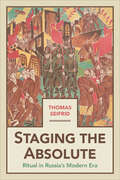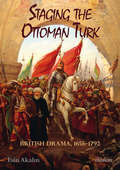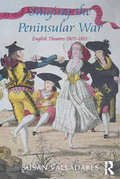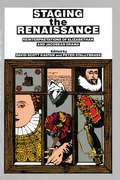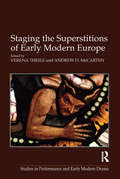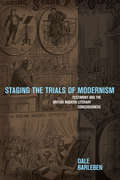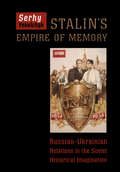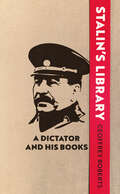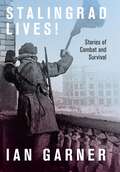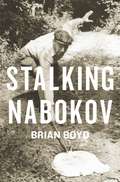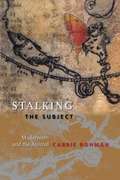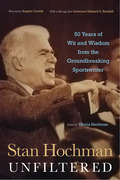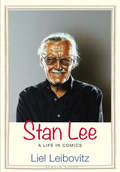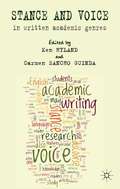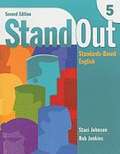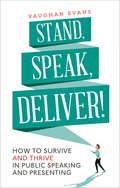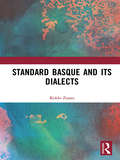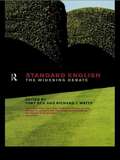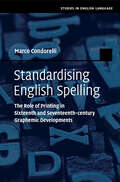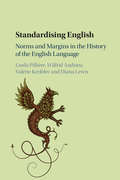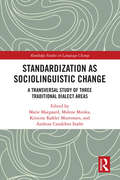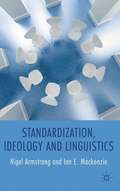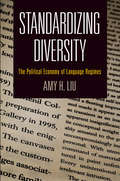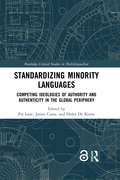- Table View
- List View
Staging the Absolute: Ritual in Russia’s Modern Era
by Thomas SeifridStaging the Absolute argues that an array of practices and beliefs came together to define an essential aspect of Russian and Soviet culture in the twentieth century: the persistent desire to interrupt – or disrupt – history. Drawing on sources that define the nature of public rituals, the book reveals the pervasive presence of the impulse to impede history in Russia’s modern era and the realization of the idea in the form of the Stalinist show trials of the 1930s. Thomas Seifrid analyses Soviet festivals, public displays of agitational propaganda, and urban planning, together with such modernist precursors as fin-de-siècle and early twentieth-century projects for reviving the theatre, modernist adaptations of puppet theatre, the Faust legend and its vogue in early twentieth-century Russia, and the nineteenth-century panorama. The book reveals that what binds these otherwise disparate phenomena together is a shared impatience with history and a corresponding desire to appropriate urban space. Illuminating the deeper meanings in these revived archaic forms, Staging the Absolute shows how pervasive the interest in disrupting history was in the Russian modern era.
Staging the Ottoman Turk: British Drama, 1656–1792
by Esin AkalınIn the wake of the fear that gripped Europe after the fall of Constantinople in 1453, English dramatists, like their continental counterparts, began representing the Ottoman Turks in plays inspired by historical events. The Ottoman milieu as a dramatic setting provided English audiences with a common experience of fascination and fear of the Other. The stereotyping of the Turks in these plays—revolving around complex themes such as tyranny, captivity, war, and conquests—arose from their perception of Islam. The Ottomans' failure in the second siege of Vienna in 1683 led to the reversal of trends in the representation of the Turks on stage. As the ascending strength of a web of European alliances began to check Ottoman expansion, what then began to dazzle the aesthetic imagination of eighteenth century England was the sultan's seraglio with images of extravaganza and decadence. In this book, Esin Akalin draws upon a selective range of seventeenth and eighteenth century plays to reach an understanding, both from a non-European perspective and Western standpoint, how one culture represents the other through discourse, historiography, and drama. The book explores a cluster of issues revolving around identity and difference in terms of history, ideology, and the politics of representation. In contextualizing political, cultural, and intellectual roots in the ideology of representing the Ottoman/Muslim as the West's Other, the author tackles with the questions of how history serves literature and to what extent literature creates history.
Staging the Peninsular War: English Theatres 1807-1815
by Susan ValladaresFrom Napoleon's invasion of Portugal in 1807 to his final defeat at Waterloo, the English theatres played a crucial role in the mediation of the Peninsular campaign. In the first in-depth study of English theatre during the Peninsular War, Susan Valladares contextualizes the theatrical treatment of the war within the larger political and ideological axes of Romantic performance. Exploring the role of spectacle in the mediation of war and the links between theatrical productions and print culture, she argues that the popularity of theatre-going and the improvisation and topicality unique to dramatic performance make the theatre an ideal lens for studying the construction of the Peninsular War in the public domain. Without simplifying the complex issues involved in the study of citizenship, communal identities, and ideological investments, Valladares recovers a wartime theatre that helped celebrate military engagements, reform political sympathies, and register the public’s complex relationship with Britain’s military campaign in the Iberian Peninsula. From its nuanced reading of Richard Brinsley Sheridan's Pizarro (1799), to its accounts of wartime productions of Shakespeare, description of performances at the minor theatres, and detailed case study of dramatic culture in Bristol, Valladares’s book reveals how theatrical entertainments reflected and helped shape public feeling on the Peninsular campaign.
Staging the Renaissance: Reinterpretations Of Elizabethan And Jacobean Drama
by David Scott Kastan Peter StallybrassThe essays in Staging the Renaissance show the theatre to be the site of a rich confluence of cultural forces, the place where social meanings are both formed and transformed. The volume unites some of the most challenging issues in contemporary Renaissance studies and some of our best-known critics, including Stephen Orgel, Margaret Ferguson, Cath
Staging the Superstitions of Early Modern Europe (Studies In Performance And Early Modern Drama Ser.)
by Andrew D. McCarthyEngaging with fiction and history-and reading both genres as texts permeated with early modern anxieties, desires, and apprehensions-this collection scrutinizes the historical intersection of early modern European superstitions and English stage literature. Contributors analyze the cultural mechanisms that shape, preserve, and transmit beliefs. They investigate where superstitions come from and how they are sustained and communicated within early modern European society. It has been proposed by scholars that once enacted on stage and thus brought into contact with the literary-dramatic perspective, belief systems that had been preserved and reinforced by historical-literary texts underwent a drastic change. By highlighting the connection between historical-literary and literary-dramatic culture, this volume tests and explores the theory that performance of superstitions opened the way to disbelief.
Staging the Trials of Modernism: Testimony and the British Modern Literary Consciousness
by Dale BarlebenIn Staging the Trials of Modernism, Dale Barleben explores the interactions among literature, cultural studies, and the law through detailed analyses of select British modern writers including Oscar Wilde, Joseph Conrad, Ford Madox Ford, and James Joyce. By tracing the relationships between the literature, authors, media, and judicial procedure of the time, Barleben illuminates the somewhat macabre element of modern British trial process, which still enacts and re-enacts itself throughout contemporary judicial systems of the British Commonwealth. Using little seen legal documents, like Ford's contempt trial decision, Staging the Trials of Modernism uncovers the conversations between the interior style of British Modern authors and the ways in which law began rethinking concepts like intent and the subconscious. Barleben’s fresh insights offer a nuanced look into the ways in which law influences literary production.
Stalin's Empire of Memory
by Serhy YekelchykBased on declassified materials from eight Ukrainian and Russian archives, Stalin's Empire of Memory, offers a complex and vivid analysis of the politics of memory under Stalinism. Using the Ukrainian republic as a case study, Serhy Yekelchyk elucidates the intricate interaction between the Kremlin, non-Russian intellectuals, and their audiences.Yekelchyk posits that contemporary representations of the past reflected the USSR's evolution into an empire with a complex hierarchy among its nations. In reality, he argues, the authorities never quite managed to control popular historical imagination or fully reconcile Russia's 'glorious past' with national mythologies of the non-Russian nationalities.Combining archival research with an innovative methodology that links scholarly and political texts with the literary works and artistic images, Stalin's Empire of Memory presents a lucid, readable text that will become a must-have for students, academics, and anyone interested in Russian history.
Stalin's Library: A Dictator and his Books
by Geoffrey RobertsA compelling intellectual biography of Stalin told through his personal library &“[A] fascinating new study.&”—Michael O&’Donnell, Wall Street Journal In this engaging life of the twentieth century&’s most self-consciously learned dictator, Geoffrey Roberts explores the books Stalin read, how he read them, and what they taught him. Stalin firmly believed in the transformative potential of words and his voracious appetite for reading guided him throughout his years. A biography as well as an intellectual portrait, this book explores all aspects of Stalin&’s tumultuous life and politics. Stalin, an avid reader from an early age, amassed a surprisingly diverse personal collection of thousands of books, many of which he marked and annotated revealing his intimate thoughts, feelings, and beliefs. Based on his wide-ranging research in Russian archives, Roberts tells the story of the creation, fragmentation, and resurrection of Stalin&’s personal library. As a true believer in communist ideology, Stalin was a fanatical idealist who hated his enemies—the bourgeoisie, kulaks, capitalists, imperialists, reactionaries, counter-revolutionaries, traitors—but detested their ideas even more.
Stalingrad Lives: Stories of Combat and Survival
by Ian GarnerIn the fall of 1942, only the city of Stalingrad stood between Soviet survival and defeat as Hitler’s army ran rampant. With the fate of the USSR hanging in the balance, Soviet propaganda chiefs sent their finest writers into the heat of battle. After six months of terrifying work, these men succeeded in creating an enduring epic of Stalingrad. Their harrowing tales of valour and heroism offered hope for millions of readers. “Stalingrad lives!” went the rallying cry: the city had to live if the nation was to stave off defeat. In Stalingrad Lives Ian Garner brings together a selection of short stories written at and after the battle. They reveal, for the first time in English, the real Russian narrative of Stalingrad – an epic story of death, martyrdom, resurrection, and utopian beginnings. Following the authors into the hellish world of Stalingrad, Garner traces how tragedy was written as triumph. He uncovers how, dealing with loss and destruction on an unimaginable scale, Soviet readers and writers embraced the story of martyred Stalingrad, embedding it into the Russian psyche for decades to come.Featuring lost work by Vasily Grossman alongside texts by luminaries such as Konstantin Simonov, Viktor Nekrasov, and Ilya Ehrenburg, Stalingrad Lives offers a literary perspective on the Soviet Union at war.
Stalking Nabokov
by Brian BoydAt the age of twenty-one, Brian Boyd wrote a thesis on Vladimir Nabokov that the famous author called "brilliant." After gaining exclusive access to the writer's archives, he wrote a two-part, award-winning biography, Vladimir Nabokov: The Russian Years (1990) and Vladimir Nabokov: The American Years (1991). This collection features essays written by Boyd since completing the biography, incorporating material he gleaned from his research as well as new discoveries and formulations.Boyd confronts Nabokov's life, career, and legacy; his art, science, and thought; his subtle humor and puzzle-like storytelling; his complex psychological portraits; and his inheritance from, reworking of, and affinities with Shakespeare, Pushkin, Tolstoy, and Machado de Assis. Boyd offers new ways of reading Nabokov's best English-language works: Lolita, Pale Fire, Ada, and the unparalleled autobiography, Speak, Memory, and he discloses otherwise unknown information about the author's world. Sharing his personal reflections, Boyd recounts the adventures, hardships, and revelations of researching Nabokov's biography and his unusual finds in the archives, including materials still awaiting publication. The first to focus on Nabokov's metaphysics, Boyd cautions against their being used as the key to unlock all of the author's secrets, showing instead the many other rooms in Nabokov's castle of fiction that need exploring, such as his humor, narrative invention, and psychological insight into characters and readers alike. Appreciating Nabokov as novelist, memoirist, poet, translator, scientist, and individual, Boyd helps us understand more than ever the author's multifaceted genius.
Stalking the Subject: Modernism and the Animal
by Carrie RohmanHuman and animal subjectivity converge in a historically unprecedented way within modernism, as evolutionary theory, imperialism, antirationalism, and psychoanalysis all grapple with the place of the human in relation to the animal. Drawing on the thought of Jacques Derrida and Georges Bataille, Carrie Rohman outlines the complex philosophical and ethical stakes involved in theorizing the animal in humanism, including the difficulty in determining an ontological place for the animal, the question of animal consciousness and language, and the paradoxical status of the human as both a primate body and a "human" mind abstracting itself from the physical and material world. Rohman then turns to the work of Joseph Conrad, D. H. Lawrence, H. G. Wells, and Djuna Barnes, authors who were deeply invested in the relationship between animality and identity. The Island of Dr. Moreau embodies a Darwinian nightmare of the evolutionary continuum; The Croquet Player thematizes the dialectic between evolutionary theory and psychoanalysis; and Women in Love, St. Mawr, and Nightwood all refuse to project animality onto others, inverting the traditional humanist position by valuing animal consciousness. A novel treatment of the animal in literature, Stalking the Subject provides vital perspective on modernism's most compelling intellectual and philosophical issues.
Stan Hochman Unfiltered: 50 Years of Wit and Wisdom from the Groundbreaking Sportswriter
by Gloria HochmanThe late Philadelphia Daily News sportswriter Stan Hochman was known for his many zingers, such as “Harry Litwack, the stoic Temple coach, stalks the sidelines like a blind man at a nudist colony.” As a reporter, he was more interested in how athletes felt, what their values were, how they lived their lives, or what made them tick than he was about how many runs they scored or punches they landed. In Stan Hochman Unfiltered, his wife Gloria collects nearly 100 of his best columns from the Daily News about baseball, horse racing, boxing, football, hockey, and basketball (both college and pro), as well as food, films, and even Liz Taylor. Each section is introduced by a friend or colleague, including Garry Maddox, Bernie Parent, Larry Merchant, and Ray Didinger, among others. Hochman penned a candid, cantankerous column about whether Pete Rose belongs in the Baseball Hall of Fame; wrote a graphic account of the Muhammad Ali and Joe Frazier fight of the century; and skewered Norman “Bottom Line” Braman, the one-time owner of the Eagles. He also wrote human-interest stories, including features about the importance of kids with special needs playing sports. In addition to being a beloved writer, Hochman was also known for his stint on WIP’s radio as the Grand Imperial Poobah, where he would settle callers’ most pressing debates. Hochman long earned the respect and admiration of his subjects, peers, and readers throughout his career, and Stan Hochman Unfiltered is a testament to his enduring legacy.
Stan Lee: A Life in Comics (Jewish Lives)
by Liel LeibovitzFrom the prizewinning Jewish Lives series, a meditation on the deeply Jewish and surprisingly spiritual roots of Stan Lee and Marvel Comics Few artists have had as much of an impact on American popular culture as Stan Lee. The characters he created—Spider-Man and Iron Man, the X-Men and the Fantastic Four—occupy Hollywood’s imagination and production schedules, generate billions at the box office, and come as close as anything we have to a shared American mythology. This illuminating biography focuses as much on Lee’s ideas as it does on his unlikely rise to stardom. It surveys his cultural and religious upbringing and draws surprising connections between celebrated comic book heroes and the ancient tales of the Bible, the Talmud, and Jewish mysticism. Was Spider-Man just a reincarnation of Cain? Is the Incredible Hulk simply Adam by another name? From close readings of Lee’s work to little-known anecdotes from Marvel’s history, the book paints a portrait of Lee that goes much deeper than one of his signature onscreen cameos.About Jewish Lives: Jewish Lives is a prizewinning series of interpretative biography designed to explore the many facets of Jewish identity. Individual volumes illuminate the imprint of Jewish figures upon literature, religion, philosophy, politics, cultural and economic life, and the arts and sciences. Subjects are paired with authors to elicit lively, deeply informed books that explore the range and depth of the Jewish experience from antiquity to the present. In 2014, the Jewish Book Council named Jewish Lives the winner of its Jewish Book of the Year Award, the first series ever to receive this award.More praise for Jewish Lives: "Excellent." – New York times "Exemplary." – Wall St. Journal "Distinguished." – New Yorker "Superb." – The Guardian
Stance and Voice in Written Academic Genres
by Ken Hyland Carmen Sancho GuindaStance and voice are among the most significant concepts in writing theory and pedagogy today. Referring to the ways we express a point of view and engage with others, the terms are particularly controversial in the domain of academic writing, long considered a faceless and impersonal kind of discourse. But while corpus research shows that stance is scarcer in academic genres than in many other contexts, the complex and distinctive ways scholars and students present their attitudes to theirtexts, their readers and their content offer a rich area of study for discourse analysts and students of academic writing. This book reappraises the notions of stance and voice and reconsiders their relevance in applied linguistics, showing their expression and impact in a broad range of written academic genres. In its 15 chapters, leading authorities offer their thoughts and research on the following issues: The key frameworks, methods, theories and areas of research The expression of stance and voice in a range of genres and disciplines The centrality of community and context in the expression of stance and voice The main factors of variation: channel, discipline, culture and temporality Questions of authenticity, distinctiveness, empowerment and identity"
Stand Out 5: Standards Based English
by Rob Jenkins Staci JohnsonBuilt from the standards necessary for adult English learners, the second edition of Stand Out gives students the foundation and tools they need to develop confidence and become independent, lifelong learners.
Stand, Speak, Deliver!: How to survive and thrive in public speaking and presenting
by Vaughan EvansPublic speaking and presenting rank in the top ten of people's greatest fears. Yet being able to speak coherently and persuasively in a speech, seminar or meeting room is important when progressing our careers and living our lives to the fullest.In this book, 37 pithy, lively and witty mini-speeches tell us how to construct and deliver a speech or presentation. Each example speech follows a simple, perfect structure which will soon become imprinted in your mind. Each focuses on one facet of speaking and gives you the very essentials picked up by the author over 25 years of experience.And each speech will entertain as much as inform you.Stand, Speak, Deliver! will enable you to learn how to use your eyes, vary your voice and move your body. It will also look at how to inform, entertain, humour, persuade, motivate or inspire the audience; how to present, to colleagues or clients; how to introduce a speaker; and how to wow as best man. And you will discover the ultimate secret...!Read the book, enjoy it and you will survive as a speaker. Follow it and you will thrive!
Stand, Speak, Deliver!: How to survive and thrive in public speaking and presenting
by Vaughan EvansPublic speaking and presenting rank in the top ten of people's greatest fears. Yet being able to speak coherently and persuasively in a speech, seminar or meeting room is important when progressing our careers and living our lives to the fullest.In this book, 37 short, lively and pithy speeches tell us how to construct and deliver a speech or presentation. Each example speech follows a simple, perfect structure which will soon become imprinted in your mind. Each focuses on one facet of speaking and gives you the very essentials picked up by the author over 25 years of experience.Stand, Speak, Deliver! will enable you to learn how to use your eyes, vary your voice and move your body. It will also look at how to inform, entertain, humour, persuade, motivate or inspire the audience; how to present, to colleagues or clients; how to introduce a speaker; and how to wow as best man. And you will discover the ultimate secret...!Read the book and you will survive as a speaker. Follow it and you will thrive!e!
Standard Basque and Its Dialects
by Koldo ZuazoThe origins of Basque dialects, a highly disputed area of research in Basque studies, are examined. The author, the foremost expert on Basque dialects, traces their emergence to medieval times, using: a) the profusion of features common to all dialects: b) the large number of innovations common to all dialects; and c) the fact that the only truly divergent dialects are the western and Souletin ones. In contrast, the three central dialects differ in far fewer and less important respects. The main contribution of Standard Basque and Its Dialects to the scholarly debate about the formation of Basque is that it identifies the nuclei from which the current dialects almost certainly emerged. The book explains the points of view that Basque speakers have upheld concerning their dialects, the formation of provincial standards starting in the eighteenth century, and the launch of Standard Basque in the second half of the twentieth century.
Standard English: The Widening Debate
by Richard J. Watts Tony BexStandard English draws together the leading international scholars in the field, who confront the debates surrounding 'Standard English', grammar and correctness head-on.These debates are as intense today as ever and extend far beyond an academic context. Current debates about the teaching of English in the school curriculum and concerns about declining standards of English are placed in a historical, social and international context. Standard English:* explores the definitions of 'Standard English', with particular attention to distinctions between spoken and written English* traces the idea of 'Standard English' from its roots in the late seventeenth century through to the present day.This is an accessible, seminal work which clarifies an increasingly confused topic. It includes contributions from: Ronald Carter, Jenny Cheshire, Tony Crowley, James Milroy, Lesley Milroy and Peter Trudgill.
Standardising English Spelling: The Role of Printing in Sixteenth and Seventeenth-century Graphemic Developments (Studies in English Language)
by Marco CondorelliThe standardisation of English spelling that resulted from the advent of printing is one of the most fascinating aspects of the history of English. This pioneering book explores new avenues of investigation into spelling development by looking at the Early Modern English period, when irregular features across graphemes became standardised. It traces the development of the English spelling system through a number of 'competing' standards, raising questions about the meaning of 'standardisation'. It introduces a new model for the analysis of large-scale graphemic developments from a diachronic perspective, and provides a new empirical method geared specifically to the study of spelling standardisation between the sixteenth and seventeenth centuries. The method is applied to four interconnected case studies, focusing on the standardisation of positional spellings, i and y, etymological spelling and vowel diacritic spelling. This book is essential reading for researchers of writing systems and the history of English.
Standardising English: Norms and Margins in the History of the English Language
by Diana Lewis Linda Pillière Wilfrid Andrieu Valérie KerfelecThis path-breaking study of the standardisation of English goes well beyond the traditional prescriptivism versus descriptivism debate. It argues that the way norms are established and enforced is the result of a complex network of social factors and cannot be explained simply by appeals to power and hegemony. It brings together insights from leading researchers to re-centre the discussion on linguistic communities and language users. It examines the philosophy underlying the urge to standardise language, and takes a closer look at both well-known and lesser-known historical dictionaries, grammars and usage guides, demonstrating that they cannot be simply labelled as 'prescriptivist'. Drawing on rich empirical data and case studies, it shows how the norm continues to function in society, influencing and affecting language users even today.
Standardization as Sociolinguistic Change: A Transversal Study of Three Traditional Dialect Areas (Routledge Studies in Language Change)
by Marie Maegaard Malene Monka Kristine Køhler Mortensen Andreas Candefors StæhrThis volume seeks to extend and expand our current understanding of the processes of language standardization, drawing on both quantitative and qualitative approaches to examine how linguistic variation plays out in various ways in everyday life in Denmark. The book compares linguistic variation across three different rural speech communities, underpinned by a transversal framework, which draws upon different methodological and analytical approaches, as well as data from different contexts across different generations, and results in a nuanced and dynamic portrait of language change in one region over time. Examining communities with varying degrees of linguistic variation with this multi-layered framework demonstrates a broader need to re-examine perceptions of language standardization as a unidirectional process, but rather as one shaped by a range of factors at the local level, including language ideologies and mediatization. A concluding chapter by eminent sociolinguist David Britain brings together the conclusions drawn from the preceding chapters and reinforces their wider implications within the field of sociolinguistics. Offering new insights into language standardization and language change, this book will be of particular interest to students and scholars in sociolinguistics, dialectology, and linguistic anthropology.
Standardization, Ideology and Linguistics
by Nigel Armstrong Ian E. MackenzieThe authors explore some of the ways in which standardization, ideology and linguistics are interrelated. Through a number of case studies they show how concepts such as grammaticality and structural change covertly rely on a false conceptualization of language, one that derives ultimately from standardization.
Standardizing Diversity: The Political Economy of Language Regimes (National and Ethnic Conflict in the 21st Century)
by Amy H. LiuLanguages have deep political significance beyond communication: a common language can strengthen cultural bonds and social trust, or it may exacerbate cultural differences and power imbalances. Language regimes that emerge from political bargains can centralize power by favoring the language of one ethnolinguistic group, share power by recognizing multiple mother tongues, or neutralize power through the use of a lingua franca. Cultural egoism, communicative efficiency, or collective equality determines the choice. As Amy H. Liu demonstrates, the conditions surrounding the choice of a language regime also have a number of implications for a nation's economy.Standardizing Diversity examines the relationship between the distribution of linguistic power and economic growth. Using a newly assembled dataset of all language-in-education policies in Asia from 1945 to 2005 and drawing on fieldwork data from Malaysia and Singapore, Liu shows language regimes that recognize a lingua franca exclusively—or at least above all others—tend to develop social trust, attract foreign investment, and stimulate economic growth. Particularly at high levels of heterogeneity, the recognition of a lingua franca fosters equality and facilitates efficiency. Her findings challenge the prevailing belief that linguistic diversity inhibits economic growth, suggesting instead that governments in even the most ethnically heterogeneous countries have institutional tools to standardize their diversity and to thrive economically.
Standardizing Minority Languages: Competing Ideologies of Authority and Authenticity in the Global Periphery (Routledge Critical Studies in Multilingualism)
by Pia Lane James Costa Haley De KorneThe Open Access version of this book, available at https://www.taylorfrancis.com/books/9781138125124, has been made available under a Creative Commons Attribution-Non Commercial-No Derivatives 4.0 license. This volume addresses a crucial, yet largely unaddressed dimension of minority language standardization, namely how social actors engage with, support, negotiate, resist and even reject such processes. The focus is on social actors rather than language as a means for analysing the complexity and tensions inherent in contemporary standardization processes. By considering the perspectives and actions of people who participate in or are affected by minority language politics, the contributors aim to provide a comparative and nuanced analysis of the complexity and tensions inherent in minority language standardisation processes. Echoing Fasold (1984), this involves a shift in focus from a sociolinguistics of language to a sociolinguistics of people. The book addresses tensions that are born of the renewed or continued need to standardize ‘language’ in the early 21st century across the world. It proposes to go beyond the traditional macro/micro dichotomy by foregrounding the role of actors as they position themselves as users of standard forms of language, oral or written, across sociolinguistic scales. Language policy processes can be seen as practices and ideologies in action and this volume therefore investigates how social actors in a wide range of geographical settings embrace, contribute to, resist and also reject (aspects of) minority language standardization.
